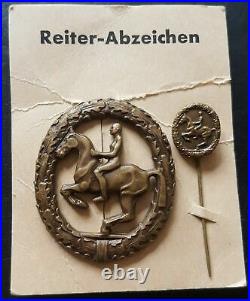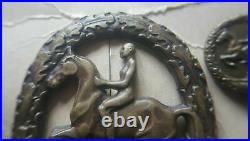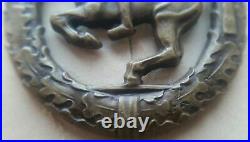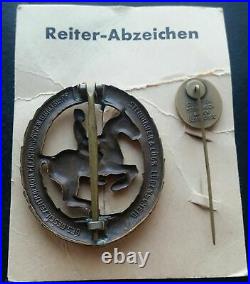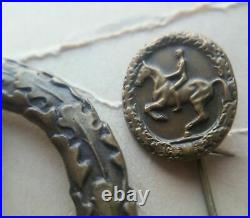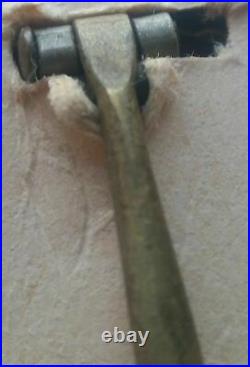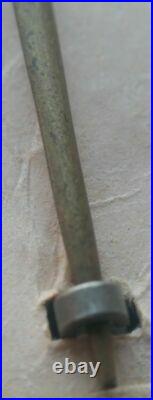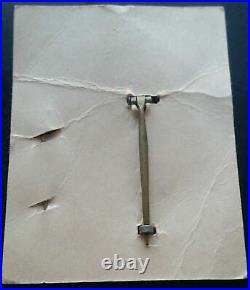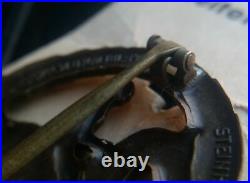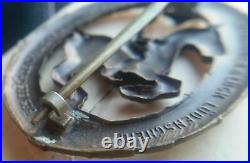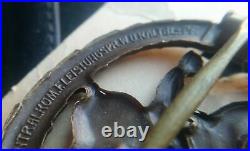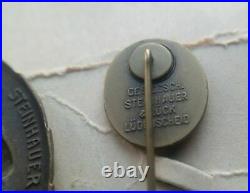Original post WW2 (1957 pattern) German Riding Badge (Das Reiterabzeichen) in Bronze on its original carton with matching stickpin – NICE EXAMPLE, MINT CONDITION, A FINE DETAILED PIECE WITH ATTRACTIVE FINISH, SIZE: cca 65 x 45 mm, RARE BADGE, MAKER: ST&L (Steinhauer und Lueck). FEW FACTS ABOUT 1957 PATTERN AWARDS. In 1957 the West German government authorised replacement Iron Crosses with an Oak Leaf Cluster in place of the swastika, similar to the Iron Crosses of 1813, 1870, and 1914, which could be worn by World War II Iron Cross recipients. The 1957 law also authorised de-Nazified versions of most other World War II-era decorations (except those specifically associated with Nazi Party organizations, such as SS Long Service medals, or with the expansion of the German Reich, such as the medals for the annexation of Austria, the Sudetenland, and the Memel region). The main government contract to manufacture and supply these new de-nazified WW2 1957 official decorations went to the world famous German firm Steinhauer & Lueck, Luedenscheid Germany. Knights Crosses, Iron Crosses, Wound Badges, Tank Assault Badges etc were re-designed by Steinhauer & Lück – often with the oak-leaf spray replacing the swastika, with S&L having the sole patent rights to all WW2 1957 German decorations. S&L did not have the whole monopoly on medal making, other famous firms such as Deschler & Sohn, BH Maher and Juncker also manufactured these new German decorations. Lüdenscheid is situated between the cities Dortmund and Bonn. It was here that one of the youngest medal firms was founded in 1889 by August Steinhauer and Gustav Adolf Lück. The first production began in a cellar, the customer base continued to increase. A property was bought at 51 Hochstrasse which is still home for this famous company today. During WW2 Steinhauer & Lück produced medals and badges, like the famous Knights Cross and many other types of medals and badges. In 1957 this company was awarded the contract to produce all the newly re-designed legal WW2 1957 de-nazified decorations, plus the contract to manufacture all of Germany’s official decorations including Germany’s highest order the Bundesverdienstkreuz. Only a very limited number of original WW2 1957 medals are still produced, mainly Iron Crosses, German Cross Gold & Silver & Wound Badges and are considered 100% genuine by the German Government. HISTORY OF THE AWARD. German Riding Badge: Das Reiterabzeichen. In 1930 the German Warmblood Association created a bronze, silver, and gold rider’s badge, Das Reiterabzeichen, to encourage increased equestrian knowledge and horsemanship. The bronze and sliver levels were awarded after demonstrated horsemanship and knowledge of riding theory, anatomy, and horsemastership. Since the Army was the largest equestrian organization in the country, Rittmeisters (cavalry captains) and artillery captains who were squadron or battery commanders were authorized to administer the tests and award the badges to civilians and to soldiers. According to German cavalry historian Klaus Richter, the army made little use of the badges. This may have been because during the same period the army was in the midst of a dramatic increase in size and modernization program encouraged by the Nazis. It also may have been because military riders, as professionals, did not see a need for a badge to represent what was already represented by their rank and branch of service. It may have been that the testing for and wearing the badges was beneath the dignity of cavalrymen and horse artillerymen. Since it was originally conceived as a civilian sports award before the Nazis came to power, it was one of the few German military qualification badges of the Nazi era that did not have a military design or include the swastika insignia. The modern Riding Badge is still issued by the German Equestrian Association (Deutsche Reiterliche Vereinigung) and still must be earned by meeting strict criteria judged by a certified looks exactly the same as the World War II and earlier version. At the copper level, level IV, the modern badge is awarded to beginner riders and is used primarily as a motivational tool to encourage a continued interest in horses. The bronze and higher requirements are more stringent. For example, a bronze level award requires successfully completing the equivalent of a USD Flevel 2 dressage test and jump course with jumps and jump combinations ranging up to 4 feet in height. There is also a written and oral test on horsemastership. The degree of control of all horse activity in Germany has no parallel in the United States. Certainly much of that control, especially in the area of stock management and breeding, goes against the grain of American principles of free markets and individual choice. However, the ability to establish national standards in horsemanship and horsemastership creates industry standards by which one can judge riding instructors, individual ability, and stable and training facilities. It also provides a national standard against which amateur horseman can measure themselves and towards which they can work improve their horsemanship. Pony Club standards are probably the only U. Measure which is similar. This item is in the category “Collectables\Militaria\World War II (1939-1945)\Medals/ Ribbons”. The seller is “a..anderson” and is located in this country: GB. This item can be shipped worldwide.
- Era: 1945-Present
- Country/ Organization: Germany
- Country/Region of Manufacture: Germany
- Theme: Militaria
- Conflict: World War II (1939-1945)
- Service: Army
- Type: Medals & Ribbons
